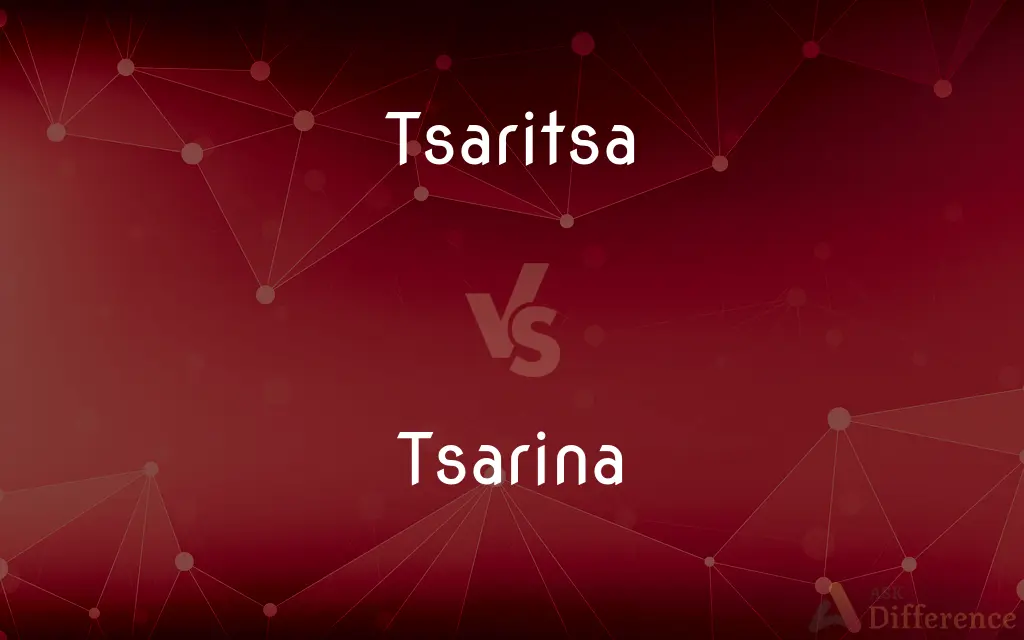Tsaritsa vs. Tsarina — What's the Difference?
By Maham Liaqat & Urooj Arif — Updated on April 8, 2024
Tsaritsa is a term used in Russian language to denote the wife of a Tsar, emphasizing her status in imperial Russia. Tsarina is the English adaptation of the same term, often used in historical contexts or English narratives about Russian royalty.

Difference Between Tsaritsa and Tsarina
Table of Contents
ADVERTISEMENT
Comparison Chart
Language
Russian
English
Usage Context
Historical and cultural discussions in Russia
International or English-speaking contexts
Cultural Connection
Strong connection to Russian heritage
Adaptation for broader audience
Historical Period
Russian Empire
Used when discussing Russian history in English
Audience
Academics, historians, Russian speakers
General international audience, English speakers
ADVERTISEMENT
Compare with Definitions
Tsaritsa
Often involved in governance and diplomacy alongside the Tsar.
The Tsaritsa was known for her diplomatic skills in managing court intrigues.
Tsarina
The English term for the wife of a Tsar, reflecting her royal status.
The Tsarina is a popular figure in historical novels about Russia.
Tsaritsa
Represents the embodiment of Russian imperial majesty and tradition.
The Tsaritsa's attire was a symbol of her status and the empire's wealth.
Tsarina
Adapts Russian historical figures for a global audience, maintaining their significance.
The Tsarina's legacy is explored in exhibitions around the world.
Tsaritsa
The wife of a Tsar in the Russian Empire.
The Tsaritsa played a crucial role in the court's politics and social life.
Tsarina
Used in English narratives to denote the female counterpart to the Tsar.
The Tsarina, alongside the Tsar, hosted lavish balls and diplomatic events.
Tsaritsa
Symbolizes the highest female royalty in Russian imperial history.
As Tsaritsa, she held significant influence over charitable activities and patronage of the arts.
Tsarina
Bridges cultural understanding in international discussions about Russian royalty.
The Tsarina's influence extended beyond the palace, affecting arts and education.
Tsaritsa
A figure of reverence and power within Russian culture.
The Tsaritsa's public appearances were occasions of great pomp and ceremony.
Tsarina
Facilitates accessibility and interest in Russian imperial history among English speakers.
Biographies of the Tsarina offer insights into the complexities of court life.
Tsaritsa
A tsarina
Tsarina
Tsarina or tsaritsa (also spelled csarina or csaricsa, tzarina or tzaritza, or czarina or czaricza; Russian: царина, царица, Bulgarian: царица) is the title of a female autocratic ruler (monarch) of Bulgaria, Serbia or Russia, or the title of a tsar's wife. The English spelling is derived from the German czarin or zarin, in the same way as the French tsarine/czarine, and the Spanish and Italian czarina/zarina.
Tsaritsa
The wife or widow of a czar
Tsarina
Variant of czarina.
Tsarina
(historical) An empress of several Eastern European countries, especially Russia, or the wife of a tsar.
Tsarina
The title of the empress of Russia. See Czarina.
Tsarina
The wife or widow of a czar
Common Curiosities
What is the difference between Tsaritsa and Tsarina?
The difference lies in the language and usage context; Tsaritsa is the Russian term, while Tsarina is the anglicized version used in English-speaking contexts.
Is the term Tsarina widely recognized outside of Russia?
Yes, Tsarina is widely recognized in English-speaking countries and is used to refer to the wife of a Tsar in historical and cultural discussions about Russia.
Who would be referred to as Tsaritsa?
The wife of a Tsar in the Russian Empire would be referred to as Tsaritsa, denoting her royal status and role.
Can Tsarina be used interchangeably with Tsaritsa?
Yes, Tsarina and Tsaritsa can be used interchangeably, though Tsarina is more common in English narratives, and Tsaritsa is preferred for cultural and historical accuracy within Russian contexts.
Does the term Tsaritsa imply a certain period in Russian history?
Tsaritsa is specifically associated with the Russian Empire period, reflecting its historical and cultural significance.
What role did the Tsaritsa play in Russian history?
The Tsaritsa played significant roles in governance, diplomacy, cultural patronage, and as a symbol of imperial majesty and tradition.
How do Tsaritsa and Tsarina reflect the status of women in the Russian Empire?
Both terms denote the high status and influential role of the Tsar's wife in the social, political, and cultural realms of the Russian Empire.
How is Tsarina used in literature and media?
Tsarina is often used in literature, historical novels, and media to make the concept of the Russian Tsar's wife accessible to a global audience.
Why might someone choose to use Tsaritsa over Tsarina in academic writing?
In academic writing, Tsaritsa might be preferred for its cultural authenticity and specificity when discussing Russian imperial history.
Are there any modern uses of the terms Tsaritsa or Tsarina?
While the Russian monarchy has been abolished, the terms Tsaritsa and Tsarina are still used in historical, cultural discussions, and in the context of discussing royal figures from the past.
Share Your Discovery

Previous Comparison
Control vs. Submission
Next Comparison
Gelatinization vs. RetrogradationAuthor Spotlight
Written by
Maham LiaqatCo-written by
Urooj ArifUrooj is a skilled content writer at Ask Difference, known for her exceptional ability to simplify complex topics into engaging and informative content. With a passion for research and a flair for clear, concise writing, she consistently delivers articles that resonate with our diverse audience.











































